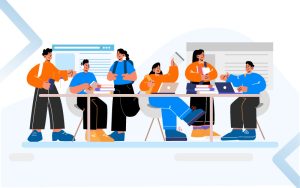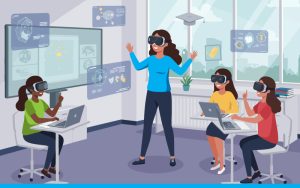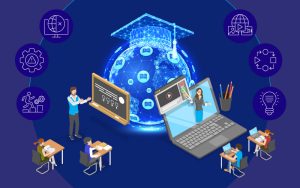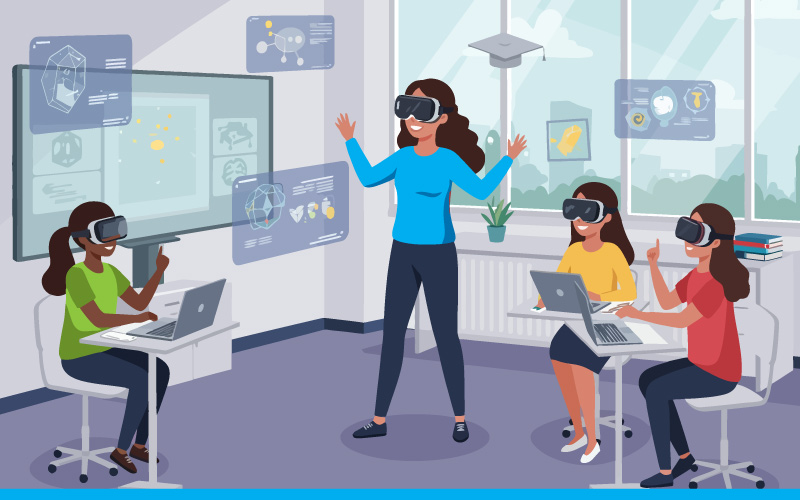The education of the next generation of STEM (science, technology, engineering, and mathematics) students will codify what will be valid and pave the way forward in innovation, technology, and science in the coming days. One of the hardest things in STEM education is making sure the content is engaging and appropriate for the different age groups. K–12 students vary in terms of cognitive development, motivation, and ability to learn, such that specific teaching strategies are required.
This blog will examine how STEM eLearning materials may be developed to satisfy the cognitive and developmental needs of students in all grade levels. By leveraging these distinctions, educators and instructional designers may create engaging eLearning experiences that enhance students’ concentration, sharpen their problem-solving abilities, and better equip them for 21st-century STEM professions.

Early Learners (K-5): Building Curiosity and Fundamental Understanding
Early childhood education is essential for fostering a love of STEM since young children are inherently interested in the field. Their cognitive abilities are still growing, and they learn best via play, storytelling, and discovery. We should try to stimulate kids’ interest at this stage rather than overloading them with technical knowledge.
Cognitive Development Considerations:
This stage is dominated by concrete thinking; abstract concepts must be rendered tactile.
Need frequent interactive engagement, as the attention spans are short.
Learning through play helps with retention and understanding.
Early learners learn best with visual and auditory learning, not text-heavy content.
Top K-5 STEM eLearning Content Best Practices:
Use Storytelling and Relatable Characters
STEM concepts can be taught through engaging storylines about animated characters or real-life role models (e.g., a young scientist or engineer).
Narratives should reflect the child’s day-to-day activities, nature, cooking, or toy play can all be connected to fundamental STEM concepts.
Utilize Interactive Simulations and Gamification
Drag-and-drop exercises, pattern recognition games, virtual puzzles – games foster active learning.
Simple cause-and-effect simulations help younger learners grasp basic scientific principles (for example, how an incline to a ramp impacts how far a toy car goes).
Introducing Coding Through Play
Children can develop games and animations and computer-based coding platforms, like Scratch Jr, improve their problem-solving skills
Coding exercises should be scaffolded and visually appealing to prevent cognitive overload.
Hands-on and Virtual Experiments
Digital laboratories that replicate simple science experiments, such as combining colors, cultivating plants, or making objects float, are used to teach STEM concepts.
Encourage at-home experiments using safe materials to improve understanding (e.g., building a volcano with baking soda and vinegar).
Use “What If” questions to pique curiosity.
STEM education needs to be inquiry-based, encouraging students to consider “what if I change this?”
Early scientific thinking is supported by encouraging young students to test their theories and create predictions.

Middle School (6-8): Strengthening Critical Thinking and Problem-Solving
Middle school children may understand increasingly complex STEM ideas as they go from tangible to more abstract reasoning. Education design should now encourage innovation, critical thinking, and a connection between STEM and the real world.
Cognitive Development Considerations:
-
Through systematic study and real-world experiments, students develop the ability to analyze hypotheses and reason logically. They gain from both practical experimentation and organized research.
-
Collaborative learning increases engagement and retention.
-
STEM applications are becoming more and more relevant in the actual world.
Best Practices for Middle School STEM eLearning Content:
Presenting Scientific Exploration and Inquiry-Based Learning
Real-world problems should be presented in lessons so that students may come up with creative answers.
Curiosity and independent thought are encouraged by open-ended questions, such as “How can we design a water filter using household materials?”
Use Interactive Simulations for Experiments
Virtual labs allow students to manipulate variables and see outcomes without being constrained by physical resources.
Engineering simulations (such as those used in bridge design and aerodynamics testing) improve experiential learning.
Develop Computational Thinking and Coding Skills
Introducing Python, JavaScript, or robotics programming in an organized manner is best done in middle school.
Coding challenges that call for debugging promote critical thinking.
Incorporate Collaborative Learning and Peer Reviews
Group projects and discussion forums encourage students to explain their thought processes and refine their reasoning.
Platforms that enable peer feedback on coding projects or design solutions help develop communication skills.
Connect STEM to Real-World Scenarios
Lessons should demonstrate how STEM is applied in various careers (e.g., “How do biomedical engineers design prosthetics?”).
Students should be encouraged to research social issues like climate change, renewable energy, or medical advancements that STEM may assist address.

High School (9-12): Preparing for Higher Education and Real-World Applications
Cognitive Development Considerations:
-
High school students can think abstractly and work through multi-step problem-solving processes.
-
Career exploration and industry connections become more relevant.
-
Independent research and project-based learning help develop autonomy.
-
Students benefit from exposure to professional tools and technologies.
Best Practices for High School STEM eLearning Content:
Implement Project-Based Learning (PBL)
Mobilizing students’ talent to work on real projects takes their learning deeper in that they can engage in project-like designing a solar car, coding an application or conducting biology research.
PBL incorporates several STEM disciplines into one challenge for the students.
Introducing Industry-Level Tools and Simulations
Access to professional-grade tools such as MATLAB, CAD software, or Arduino for electronics encourages students to develop skills applicable in the industry.
Some coding environments that are more advanced like python, R or C++ might be used to introduce students to the course work and what is expected of them in college and STEM careers.
Foster Career Exploration and Mentorship Opportunities
Students are made aware of the importance of STEM careers through virtual job shadowing, webinars with STEM professionals, and guided career pathways.
Participation in STEM competitions, such as robotics challenges and hackathons, is instrumental in developing confidence along with practical experience among students.
Encourage Independent Research and Innovations
Allow students to choose research topics and explore STEM problems that interest them.
Open capstone project, of which its outcome is not deterministically known pushes learners to design solutions for humanitarian or global problems (e.g., simulating a model of a sustainable city).
Develop Critical Thinking through Ethical and Societal Discussions
Discourse on ethical challenges in STEM (e.g., AI and data privacy, gene editing, environmental sustainability) is instrumental in developing subordinate thinking skills.
Discussion and case studies encourage students to think about the wider implications of STEM development.

A Developmentally Appropriate Approach to STEM eLearning
To create successful STEM eLearning content for K12 education teachers must possess thorough knowledge about different cognitive developmental levels and student learning behaviors.
-
Early learners who are aged between K-5 should experience interactive educational activities through exploration because this promotes their curiosity.
-
The educational needs of 6-8-year-old middle school students include structured problem-solving with collaborative activities and opportunities to apply their learning to real-world scenarios.
-
Students in grades 9 through 12 need projects that align with their educational stage and interactive experience with professional tools and career research for their academic advancement

Let’s Build the Future of STEM Learning Together
At Mitr Learning & Media, we are dedicated to producing interactive digital learning solutions specifically designed for specific age groups while delivering impactful content that serves all education needs. Our proficiency in eLearning development, immersive technology, and instructional design enables us to create engaging content for early learning activities, middle school problem-solving, and project-based high school education, among other STEM education levels.
Together, let’s create top-notch STEM eLearning courses that stimulate students’ curiosity, foster critical thinking, and get them ready for the future.
Contact our team right to discover how we will deliver meaningful STEM experiences that engage each student.
What’s Next?

Want to dive deeper? Check out our related blogs:
Each classroom is unique in a number of ways. Content must be comprehensive, adaptable, and sensitive to various requirements in order to reach every student.
Here are some strategies that help:
- Language support: Provide translations, audio help, or subtitles wherever possible. For many students, even the ability to slow down narration has a significant impact.
- Cultural relevance: Use examples that reflect different regions and contexts. A unit on agriculture can compare farming in different climates or economies.
- Accessibility design: Stick to the basics of Universal Design for Learning. Clear fonts, alt text, simple navigation, and compatibility with screen readers make the content usable for everyone.
I once saw a class respond incredibly well to a unit that included weather patterns from their region. They felt seen, and they were excited to participate.
Conclusion
Though it doesn’t have to be difficult, STEM eLearning must be well-considered. The most effective teaching resembles an invitation to experiment.
Learners will recall experiences that are inclusive, age-appropriate, participatory, and visually appealing. Students are more inclined to continue learning even after the module is over when they believe that the material is theirs.
STEM education is about more than simply getting pupils ready for the workforce. It’s about providing them the knowledge and self-assurance to make changes in the world they live in.
Let’s create learning that does just that.

What’s Next?
Want to dive deeper? Check out our related blogs:
-
Harnessing Visual Storytelling to Simplify Complex STEM Topics
-
Gamification in STEM eLearning: Strategies for K12 Success
-
The Science of Engagement: What Makes STEM Content Effective in K12?
-
Designing Interactive eLearning Content for STEM Education in K12 Schools
-
Adapting STEM eLearning Content for Multilingual and Diverse Classrooms









